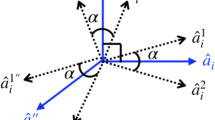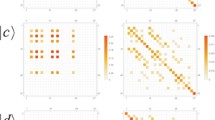Abstract
We discuss the notion of bound entanglement (BE) for continuous variables (CV). We show that the set of non-distillable states (NDS) for CV is nowhere dense in the set of all states, i.e., the states of infinite-dimensional bipartite systems are generically distillable. This automatically implies that the sets of separable states, entangled states with positive partial transpose, and bound entangled states are also nowhere dense in the set of all states. All these properties significantly distinguish quantum CV systems from the spin like ones. The aspects of the definition of BE for CV is also analysed, especially in context of Schmidt numbers theory. In particular the main result is generalised by means of arbitrary Schmidt number and single copy regime.
Access this chapter
Tax calculation will be finalised at checkout
Purchases are for personal use only
Preview
Unable to display preview. Download preview PDF.
Similar content being viewed by others
References
M. Horodecki, P. Horodecki and R. Horodecki, Phys. Rev. Lett. 80, 5239 (1998).
C. H. Bennett, G. Brassard, S. Popescu, B. Schumacher, J. Smolin and W. K. Wootters, Phys. Rev. Lett. 76, 722 (1996).
P. Horodecki, M. Horodecki and R. Horodecki, Phys. Rev. Lett. 82, 1046 (1999).
M. Murao, V. Vedral, Phys. Rev. Lett. 86, 352 (2001); P. W. Shor, J. A. Smolin, and A. V. Thapliyal, quant-ph/0005117.
W. Dür, J. I. Cirac, and R. Tarrach, Phys. Rev. Lett. 83, 3562 (1999)
W. Dür and J. I. Cirac, Phys. Rev. A 62, 22302 (2000).
See S. Braunstein and J. Kimble, quant-ph/9910010, and references therein; for experiments see A. Furusawa et al. Science 282, 706 (1998).
P. Horodecki and M. Lewenstein, Phys. Rev. Lett. 85, 2657 (2000).
R. F. Werner and M. M. Wolf, Phys. Rev. Lett. 86, 3658 (2001).
K. Życzkowski, P. Horodecki, A. Sanpera and M. Lewenstein, Phys. Rev. A 58 833 (1998)
K. Życzkowski, Phys. Rev. A 60 3496 (1999).
G. Vidal, R. Tarrach, Phys. Rev. A 59 141 (1999).
S. L. Braunstein, C. M. Caves, R. Jozsa, N. Linden, S. Popescu and R. Schack: Phys. Rev. Lett. 83, 1054 (1999)
R. Schack and C. M. Caves, Phys. Rev. A 60, 4354 (1999).
N. Linden and S. Popescu, Phys. Rev. Lett. 87, 047901 (2001).
R. Clifton and H. Halvorson, Phys. Rev. A 61, 012108 (2000).
B. M. Terhal and P. Horodecki, Phys. Rev. A 61, 040301(R) (2000).
M. Horodecki and P. Horodecki, Phys. Rev. A 59, 4026 (1999).
M. Horodecki, P. Horodecki and R. Horodecki, Phys. Rev. A 60, 1888 (1999).
R. V. Kadison and J. R. Ringrose, “Fundamentals of the Theory of Operator Algebras”, Academic Press, (1983).
A. Peres, Phys. Rev. Lett. 77, 1413 (1996).
L.-M. Duan, G. Giedke, J. I. Cirac, and P. Zoller, Phys. Rev. Lett. 84, 2722 (2000).
R. Simon, Phys. Rev. Lett. 84 2726 (2000).
G. Giedke,, L. M. Duan, J. I. Cirac, and P. Zoller, quant-ph/0007061.
M. Lewenstein and A. Sanpera, Phys. Rev. Lett. 80, 2261 (1998)
A. Sanpera, R. Tarrach and G. Vidal, Phys. Rev. A 58, 826 (1998).
B. Kraus, J. I. Cirac, S. Karnas, and M. Lewenstein, Phys. Rev. A 61, 062302 (2000)
P. Horodecki, M. Lewenstein, G. Vidal, and J. I. Cirac, Phys. Rev. A 62, 032310 (2000).
M. Lewenstein, B. Kraus, J. I. Cirac, and P. Horodecki, Phys. Rev. 62, 052310 (2000).
M. Lewenstein, B. Kraus, P. Horodecki, and J. I. Cirac, Phys. Rev. 63, 044304 (2001).
G. Giedke, B. Kraus, M. Lewenstein and J. I. Cirac, Phys. Rev. A 64, 052303 (2001).
G. Giedke, B. Kraus, M. Lewenstein and J. I. Cirac, Phys. Rev. Lett. 87, 167904 (2001).
G. Giedke, L.-M. Duan, J. I. Cirac and P. Zoller, Quant. Inf. Comp. 1(3), 79 (2001).
D.P. DiVincenzo, P. W. Shor, J. A. Smolin, B. Terhal and A. Thapliyal, Phys. Rev. A, 61 062312 (2000)
W. Dür, J. I. Cirac, M. Lewenstein and D. Bruss, Phys. Rev. A 61 062313 (2000).
P. W. Shor, J. A. Smolin, and B. M. Terhal, Phys. Rev. Lett. 86, 2681 (2001).
L. P. Hughston, R. Jozsa and W. W. Wooters, Phys. Lett. A 183, 14 (1993).
A. Sanpera, D. Bruss, M. Lewenstein, Phys. Rev. A 63, 050301 (R) (2001).
B. Terhal, Lin. Algebr. Appl. 323, 61 (2000).
M. Horodecki, P. Horodecki, R. Horodecki, Phys. Lett. A 223, 1 (1996)
N. Cerf, C. Adami, and R. M. Gingrich, Phys. Rev. 60, 898 (1999).
Author information
Authors and Affiliations
Editor information
Editors and Affiliations
Rights and permissions
Copyright information
© 2003 Kluwer Academic Publishers
About this chapter
Cite this chapter
Horodecki, P., Cirac, J.I., Lewenstein, M. (2003). Bound Entanglement for Continuous Variables is a Rare Phenomenon. In: Braunstein, S.L., Pati, A.K. (eds) Quantum Information with Continuous Variables. Springer, Dordrecht. https://doi.org/10.1007/978-94-015-1258-9_17
Download citation
DOI: https://doi.org/10.1007/978-94-015-1258-9_17
Publisher Name: Springer, Dordrecht
Print ISBN: 978-90-481-6255-0
Online ISBN: 978-94-015-1258-9
eBook Packages: Springer Book Archive




